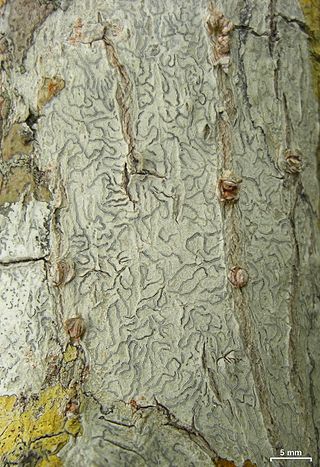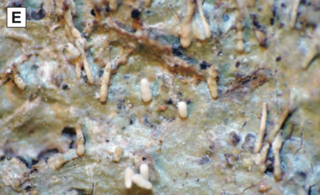
The Graphidaceae are a family of lichen-forming fungi in the order Graphidales. The family contains nearly a hundred genera and more than 2000 species. Although the family has a cosmopolitan distribution, most Graphidaceae species occur in tropical regions, and typically grow on bark.

Platygramme is a genus of lichen-forming fungi in the family Graphidaceae consisting of about 30 species. The genus was circumscribed by Antoine Laurent Apollinaire Fée in 1874.

Fissurina is a genus of lichenized fungi in the family Graphidaceae. It has about 160 species, most of which are found in tropical regions.

Diorygma is a genus of lichen-forming fungi in the family Graphidaceae. The genus was circumscribed by Franz Gerhard Eschweiler in 1824. Species of the genus are widely distributed in tropical and subtropical regions of the world.
Carbacanthographis is a genus of corticolous (bark-dwelling) lichens in the family Graphidaceae. The genus was circumscribed by German lichenologists Bettina Staiger and Klaus Kalb in 2002. An updated worldwide key to the genus was published in 2022 that added 17 new species.

Acanthothecis is a genus of lichen-forming fungi in the family Graphidaceae. The genus was circumscribed by Frederick Edward Clements in 1909.

Acanthotrema is a genus of lichens in the family Graphidaceae. The genus was circumscribed by German lichenologist Andreas Frisch in 2006, with Acanthotrema brasilianum assigned as the type species. Acanthotrema species are commonly found in rainforests ranging from lowland to montane environments.

Cryptothecia is a genus of white to greenish crustose lichens that grow on bark, wood, or leaves, in tropical or subtropical areas worldwide. It has a conspicuous prothallus that develops around its periphery which can be bright red in some species, hence the common name wreath lichen. The main vegetative body (thallus) lacks a cortex (ecorticate and is often immersed in the substrate or byssoid. The medulla is white, well defined, and often peppered with calcium oxalate crystals. Ascomata are not well defined, being cushions of soft white mycelium immersed in the medullary tissue, hence the name from the Greek krypto = "to conceal" and theke = "a container or sheath". It contains Trentepohlia, a green alga, as its photobiont partner.
André Aptroot is a Dutch mycologist and lichenologist.

Malmidea is a genus of crustose lichens and the type genus of the family Malmideaceae. It was established in 2011 to contain a phylogenetically distinct group of species formerly placed in the genus Malcolmiella. The crust-like thallus of Malmidea lichens has a surface that varies from smooth to rough, featuring textures such as verrucose (wart-like), granulose (grainy), or pustulate (pimpled). These textures are often formed by goniocysts, which are spherical clusters of green algal cells from the family Chlorococcaceae, encased in fungal hyphae. Malmidea comprises nearly 70 mostly tropical species that grow on bark, although a few grow on leaves.
Pseudochapsa is a genus of lichen-forming fungi in the family Graphidaceae. It has 19 species. It was circumscribed in 2012 by Sittiporn Parnmen, Robert Lücking, and Helge Thorsten Lumbsch, with Pseudochapsa dilatata as the type species. Pseudochapsa differs from Chapsa it that its excipulum is typically brown. Additionally, its ascospores are mostly discoseptate and amyloid. The generic name combines the Greek pseudo ("false") with the genus name Chapsa.
Cruentotrema is a genus of corticolous (bark-dwelling) lichens in the family Graphidaceae. It has seven species.
Gintarasia is a genus of lichen-forming fungi in the family Graphidaceae. It has seven species, all of which are found in Australia. Gintarasia species are corticolous (bark-dwelling), crustose lichens with a thelotremoid form.
Cruentotrema amazonum is a little-known species of script lichen in the family Graphidaceae. It is found in Brazil, Thailand, and Vietnam, where it grows in the understory of primary rainforests.
Fissurina amazonica is a little-known species of corticolous (bark-dwelling) script lichen in the family Graphidaceae. Found in Brazil, it is a shade-loving species that thrives in the understory of undisturbed rainforests.
Fissurina amyloidea is a little-known species of script lichen in the family Graphidaceae. It is found in the primary rainforests of Rondônia, Brazil. It is characterized by its weakly carbonizedlirellae and thick-walled, strongly amyloid ascospores. Despite its superficial similarity to Fissurina subfurfuracea, F. amyloidea exhibits unique anatomical features that set it apart from other species within the genus.
Fissurina chrysocarpa is a little-known species of script lichen in the family Graphidaceae. Found primarily in the rainforests of Rondônia, Brazil, it is distinguished by its bright orange lirellae.
Fissurina duplicans is a little-known species of corticolous (bark-dwelling) script lichen in the family Graphidaceae. It is found in primary rainforests of Brazil. The lichen has an endoperidermal thallus and a double margin of lirellae, setting it apart from similar species.
Aggregatorygma lichexanthonicum is a species of corticolous, crustose lichen in the family Graphidaceae. Found in Brazil, it is characterised by the presence of lichexanthone in its thallus.







